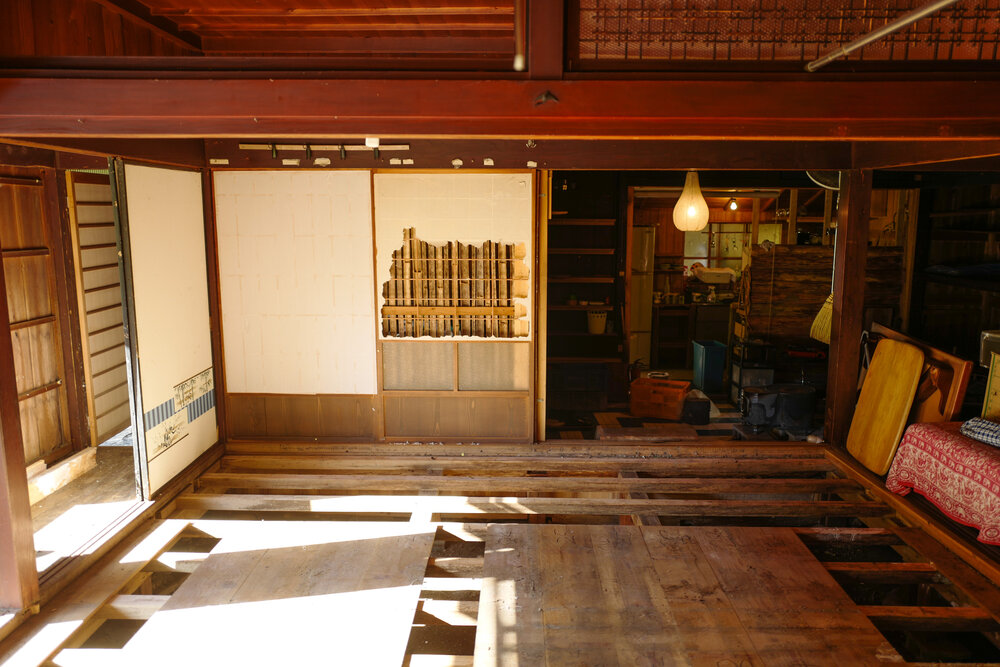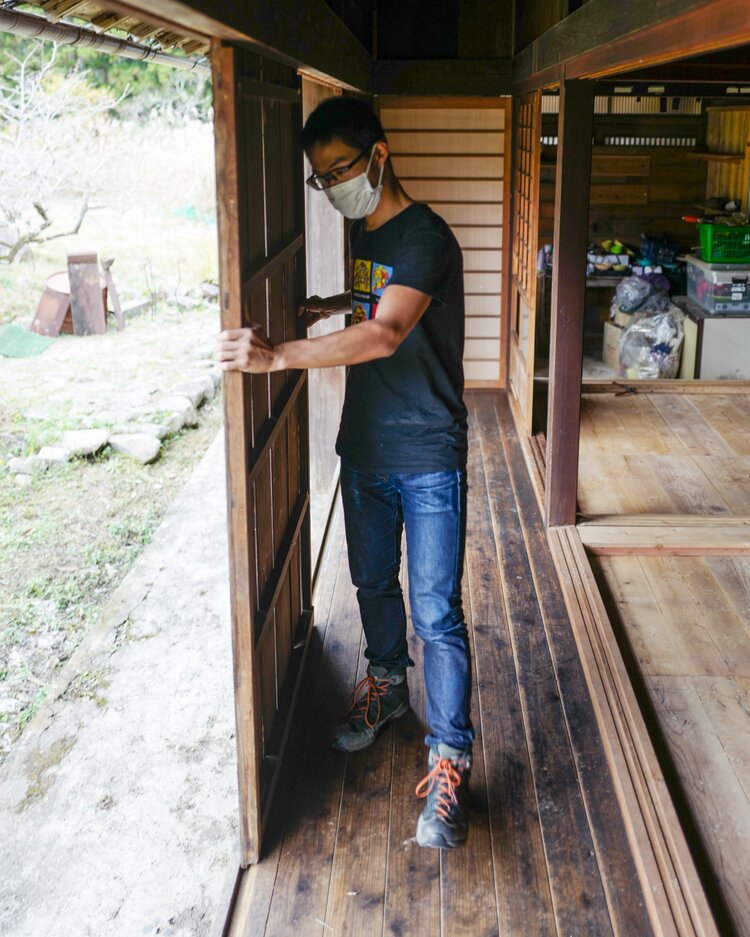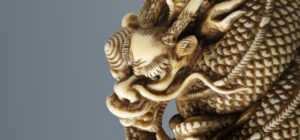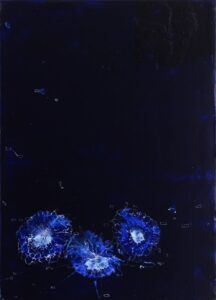„Anyone who equates country life with a peaceful idyll is a dreamer and, above all, an idiot.” Wow, that sentence really hit home. Where did I hear this harsh analysis? In the Bavarian foothills of the Alps. A sprightly farmer’s wife had slapped this wisdom on my head when my husband and I were looking at a property to rent in the countryside. And hey, we didn’t want to run a farm or anything like this, we just wanted to live there….
O.k. – so be it. There may also be some truth to it. That means, anyone who moves his life „to the countryside“ should probably bring a certain realism about the challenges ahead. But is there really no room for dreams at all? No ideals? Nothing of all of that?
I would love to talk about dreams and values, but especially about his motivation and his goals, with someone who has actually moved his life entirely to the countryside with a farm-to-table project: Lee Xian Jie. Only here, we are not talking about the Bavarian foothills, but Ryujinmura, a village deep in the mountains of Wakayama in Japan.
So what is so interesting about talking to someone who lives in the middle of nowhere in Japan? A lot – as Ryunohara’s story is about ideals and dreams, at least that`s what I suppose. However, we are talking about dreams that have nothing at all in common with castles in the air. On the contrary, these dreams require a lot of commitment and work to come to life.

What is the idea behind Ryunohara? A café? A farm? Or just a dropout project?
Let’s start with Ryujinmura (Dragon God Village), a village with about 3.500 inhabitants deep in the mountains of the Kumano region. Mainstream attractions or tourist streams may not to be expected here. What is there instead is a traditional rural living area framed by nature, nature and nature again. The surrounding is impressive, no flat land but forested mountains, valleys from which the mist is rising, rivers winding through the valleys.

Here and there – isolated clusters of houses – as also the human being has to find his place somewhere. Lee’s neighbors are growing vegetables, local businesses and artisans keep the world going. I guess we are talking about just normal rural life in Japan here. However, what Ryujinmura is known for, are its Onsen, meaning hot thermal baths, as well as the corresponding infrastructure around them. That means some few visitors should come to Ryujinmura from time to time.
Are there many young people still living in Ryujinmura? I don’t know exactly, but I dare to doubt it. The reason is that many rural regions in Japan have something in common: rural exodus. Young people move to the cities to find „well-paid“ jobs and other so-called amenities. As a result, many, many acres of land as well as the respective houses lie fallow in rural areas. They are simply abandoned. I guess it was a quiet life that Lee found in Ryujinmura.
Yet, this is exactly where Lee, a native Singaporean, simply started. Now he takes care of a piece of land (half an acre) with three old farmhouses (kominka) on it. His land is about 5 kilometers away from the local Onsens. What he has planned to do there? He wants to open a farm-to-table café where his guests can enjoy specialties from Singapore and from Ryujinmura, made from natural foods that he grows himself or buys from the neighbors, with tea and honey from his own harvest. He even wants to offer tea seminars one day, as tea simply grows naturally on his land or in the forest around.
Sounds good – but comes quite with hurdles, as his piece of land was not cultivated for some time as well. The houses, one is even 120 years old, stood empty and… well, did not turn to the better by the vacancy. Therefore, the first thing to do was to clean up the jungle he had leased and, above all, to make one of the houses habitable again. Before the pandemic hit, Lee had been working and living full time as a self-employed tour guide in Kyoto.
Ryunohara: what does it take to bring fallow farmland and an abandoned house in Japan back to life?
So what has Lee already accomplished at this point? Let’s have a look at the most obvious – the “battle” against the jungle…. even if I don’t really like the word battle. Anyway, first of all, Lee has tackled the overgrown land and cleared it, mostly with a motor scythe, because, as mentioned, it is quite uneven land. He has exposed and tended old plants again, such as trees and tea bushes, planted flowers and set up beehives. In addition, he has created vegetable patches in front of his house where he strictly follows the principle of no-dig (Charles Dowding), no pesticides, no chemical fertilizer, which means, a completely natural cultivation that does not pollute or exploit the land and the soil.
One of the three houses on Lees ground is uninhabitable. That’s really a pity. The ravages of time has destroyed it to the most extent. By the way, this can happen relatively quickly with Japanese uninhabited houses, as traditional houses are mainly built of organic materials, such as wood, straw or paper. Lee’s houses are also built in this traditional wooden style. They are old Japanese farmhouses (kominka), exactly what you would love to watch in a Japanese coffee-table book.
The farmhouse where he is now living by himself, together with his two dogs, needed some renovation as well. This should not be surprising, since the house is 120 years old. About the renovation itself, I simply recommend watching Lee’s YouTube videos. They show the whole process of the renovation and they are exciting. One of the videos is titled „I fell through the floorboard at my 120-year-old Japanese Farmhouse“ – which means that the renovation of the house was really a matter of substance – from the foundation to the wooden floor to the gutter.

In addition to that: some new tatami-mats, the installation of a traditional fireplace in the house and many other smaller and larger construction projects. Fortunately, there seem to be craftsmen in the area who still know the traditional crafts and techniques required for such house renovations. You can see their work in the videos as well.

The third farmhouse is being converted into the actual café… is being… wrong, of course Lee is converting it himself, with the help of good friends who, for example, helped to re-cover the zinc roof. Professional help was still needed for example in the installation of a septic tank, a modern sanitary area or the renovation of the kitchen for the café. By the way, the café will open in August 2022.

House renovation in Japan: the aesthetic principles of old Japanese houses – Kominka
Now, let’s have a look on what I personally admire most at Ryunohara. I’m talking about the aesthetics, the beauty that Lee preserves and creates here. Take the 120-year-old farmhouse where he is living now. This classic wooden house is fascinatingly simple and, in my eyes, beautiful for that very reason. Therefore, what catches my eye is a real treasure of classic Japanese aesthetics. And yes, I know, it is easy to talk about “beauty” if you don’t feel the work in your bones, which was necessary to create this beauty.
The love for material in a Japanese house (Kominka)
Anyway, if we take a dreamy-transfigured look at the house, many wonderful aspects stand out. For unlike modern houses, this kominka is built of massive wooden beams, which are visible in their unpretentious way throughout the complete living area. On top of a solid roof-construction sits a traditional thatched roof (kayabuki), which in turn is covered with a zinc roof for protection. Looking at such a thatched roof, which can be up to half a meter in thickness, is overwhelming. Another eye-catcher: the wooden floorboards of the traditional veranda (engawa) that leads around the house. The planks shimmer darkly, as they are naturally oiled and polished. I really love the engawa. It invites you to sit and stay, even if it is raining, as you still sit well protected under the overhanging thatched roof. Overall, a calming atmosphere emanates from this kominka, not least because there are virtually no artificial materials to be seen. Even the exterior and interior walls are wooden throughout.
Light and shadow in a Japanese house (Kominka)
Inside the house, beside the intense look and feel of the material wood, another aspect fascinates me: the light. The tatami-mats in their pleasant light coloration mark the living space located inside. New tatami has a light to slightly greenish color and darkens only with time. They are the “light” counterpart to the dark wood all around. Light also falls through the sliding doors between the rooms, which are now covered with new Japanese paper (washi), of course made by the local papermaker. It is a milky, slightly pale light that falls on the bright tatami-matts. When all the sliding doors are open, both the inside ones and the outer ones, the house is flooded with daylight, with the result that the feeling of inside and outside becomes blurred.
The light meets the darkness inside the house. This impression is created because the wooden walls are of very dark color, as are the sliding doors of the cabinets (fusuma) or the sliding doors between the rooms (shoji). If all door-elements are closed in the evening or in the case of bad weather, darkness reigns in the house. Of course, this does not mean that Lee has no lamps throughout the house. However, many of them are low floor lamps made of paper, which shine in warm light and, above all, channel the light. Overly bright or room-filling light sources are the exception.
Is that beautiful? A luxurious interior with golden fusuma or ostentatious objects is rather absent in this house. That is right – there is none of that. What there is, however, is the delicate play of light and darkness, which is the real elegance of such a house. That means celebrating the praise of shadows! Just one more thing: The aesthetic feeling described here, the appreciation for the play with light and shadow; all this reflects the attitude towards life and the aesthetic feeling of bygone times. Junichiro Tanizaki impressively described this in his essay „The praise of shadows“. Worth to mention, this aesthetic feeling grew in a time when electric light did not even exist.
The traditional details in a Japanese house (Kominka)
Another wonderful detail that I particularly like about Lee’s kominka: the classic fireplace (irori) inside the house. From the ceiling, the wrought iron hook hangs down to the fireplace to hold teakettles or pots over the fire. In times past, fireplaces like this were the heart of the home. This was the place where people traditionally cooked, ate and sat. Sometimes Lee sits at his irori to roast the tea he harvested behind the house or grills fish over the glowing charcoal (binchotan, by the way, another centuries-old craft in Japan).
House and yard, as already described, are surrounded by rich nature. Of course, this is also an important aspect in terms of aesthetic sensation. After all, the view from the house falls into the greenery in summer and in winter on a thick blanket of snow. All this is beautiful, gorgeous even, but it also comes with pitfalls – in the form of insects, snakes lying in the tall grass, or even monkeys that want to raid the vegetable patch. The snow may be the least of all the challenges. Life here wants to be lived as the house, nature and the rhythms of nature dictate it. I guess his two dogs will also set a good part of Lee’s rhythm of life. It is a unique way of life – I would say – at least a different rhythm of life compared to the city, together with friends and the people of the village.
Is it comfortable to live in the countryside and in an old Kominka?
So life in the Japanese mountains seems to be nice – but is it always comfortable or convenient to live here in the countryside or in such an old house? Well, I guess Lee will have renounced excessive comfort, at least at the beginning of his journey. Of course, in houses of this type there was no central heating or air conditioning, no modern bathroom with underfloor heating. A kominka like this is cold in winter (Lee currently heats with small kerosene stoves), hot in summer (small mobile coolers and smokers help against heat and mosquitoes). A kominka is not a self-run. You have to care for it, ventilate it, love it. Life here may be magical, but only if you see it that way.
Generations of Japanese before wanted to leave exactly this way of life behind. They wanted to leave the poor and uncomfortable life in the dark „wooden shacks“. Yes, they longed for bright modern rooms with glaring halogen lights. The problem that so many old houses in Japan are abandoned arose several generations ago, when those who were still living the traditional lifestyle sought to move away.
Why has Lee decided to live in the countryside to work on Ryunohara?
In fact, Lee lives a very different life compared to many millions of Japanese people in his age. He is certainly not a classic „salaryman“ who lives in a small but modern apartment in the city. His life even seems to me like a drastic antithesis to the city-life of modern Japan.
And here comes the relevant question: why is Lee actually doing all this? What are the reasons for committing himself to this project and this way of life? I suppose he has good reasons, as maybe he is a dreamer after all, but certainly not an idiot. I am simply interested in the reasons that motivate people to tackle such projects.
Honestly, what Ryunohara reminds me of – the project with the café, the farm and the old kominka – are projects in the mood of Alex Kerr or Sarah Marie Cummings. Many years ago, they dedicated themselves to the preservation of old houses (Alex Kerr), or of old cultural assets and their techniques, such as an old sake brewery (Sarah Marie Cummings). Ultimately, Sarah Marie Cummings also restored old houses around her sake brewery and promoted traditional cultural life there. What is remarkable about this, however, is that there were often foreigners (there are numerous other examples) who saw the beauty and cultural value of „old Japan,“ the Japan that, as I said, generations of Japanese rejected as poor and outdated. I do not want to judge this at all. However, maybe sometimes it really needs the view from „outside“ to see the beauty and the true depth of past times. Kerr, Cummings and Co. are all about preserving Japan in all its aesthetics and sustainability.
And Lee? What is his self-image? Does he see himself in the tradition of Kerr and Cummings, or is he driven by something completely different? How important is the aspect of aesthetics to him? Moreover, what does tradition and sustainability means to him? Or is he simply one of many young people in Japan who are now taking such steps with increasing frequency? With other words, are we talking about a turning point in Japan – or at least about a continuing process of change towards a different way of life?
I will try to find out and ask Lee about it. So be curious. To be continued…
Here is the link to the Ryunohara farm website





Schreibe einen Kommentar